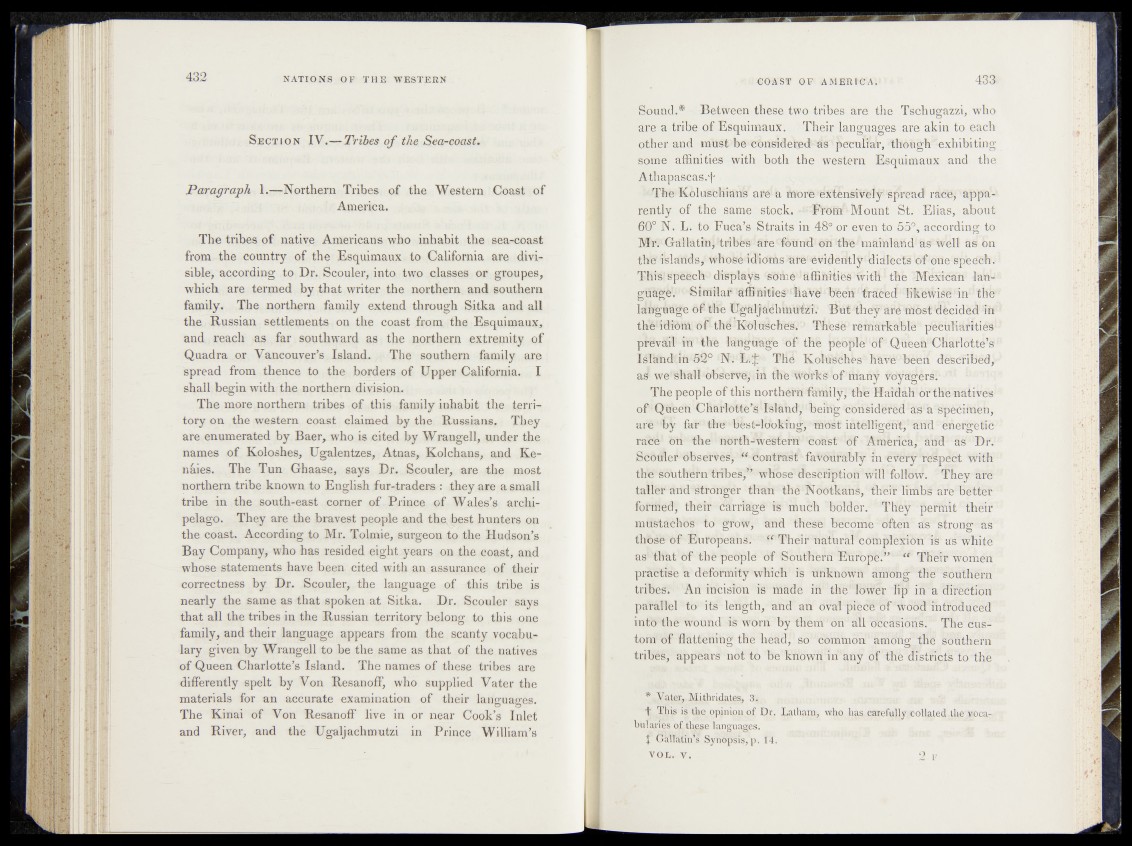
Section IV.— Tribes o f the Sea-coast.
Paragraph 1.—Northern Tribes of the Western Coast of
America.
The tribes of native Americans who inhabit the sea-coast
from.: the country of the Esquimaux to California are divisible,
according to Dr. Scouler, into two classes or groupes,
which are termed by that writer the northern and southern
family. The northern family extend through Sitka and all
the Russian settlements on the coast from the Esquimaux,
and reach as far southward as the northern extremity of
Quadra or Vancouver’s Island. The southern family are
spread from thence to the borders of Upper California. I
shall begin with the northern division.
The more northern tribes of this family inhabit the territory
on the western coast claimed by the Russians, They
are enumerated by Baer, who is cited by Wrangell, under the
names of Koloshes, Ugalentzes, Atnas, Kolchans, and Re-
naies. The Tun Ghaase, says Dr. Scouler, are the most
northern tribe known to English fur-traders : they are a small
tribe in the south-east corner of Prince of Wales’s archipelago.
They are the bravest people and the, best hunters on
the coast. According to Mr. Tolmie, surgeon to the Hudson’s
Bay Company, who has resided eight years on the coast, and
whose statements have been cited with an assurance of their
correctness by Dr. Scouler, the language of this tribe is
nearly the same as that spoken at Sitka. Dr. Scouler says
that all the tribes in the Russian territory belong to this one
family, and their language appears from the scanty vocabulary
given by Wrangell to be the same as that of the natives
of Queen Charlotte’s Island. The names of these tribes are
differently spelt by Von Resanoff, who supplied Vater the
materials for an accurate examination of their languages.
The Kinai of Von Resanoff live in or near Cook’s Inlet
and River, and the Ugaljachmutzi in Prince William’s
Sound,# Between - these two* tribes. afë • the Tschugazzi,. who
are a tribe of Esquimaux. Their-languagés ,are akin to each
othe r an d rahStbe^rMd efgcNis'' pectrMr, dftèbgk^exb ibitin g
some' .affinities-with both the -western Esquimaux and the
Athapascas.f: ,v..
• Tbbitóluffchferi® avéh réêS^t^ife.1-®
rently of the same stock, i f fMo u n t i t f f t . Elias, about
6®° N. L. to Fuca’s&j§traits in ^ ^ d r; everi^^^iamaecording to
M # U0bn
tl^^l^^s/^ttlobéd^nfAs^fë^yidëml^diEilèc^lÉPdfte^fed^li.
THMlspêMch^dis|dayfe some affinities with Ifife laft^
language ê# Wb wcidSn4ö’
th&idïtöö! oP th§lEöltSche^,° retndfkS*6tes pSëtffiHmiéë*
phW0* itf tïrè b f th%
The Koltóëh4s&n%;vé0bèëTi described,
a s we^hali%bdetV8,’-im thfe - b ^ k ^ f niahy f ^ ^ g e r# * * 1
The people of this northéi^dÖnhl^'thb
of* Qifeëfi 'Ch&rl^tè’ërislahd,*' beft% 4ibriMdëfêét
artr*%y far ‘ thë ^st4ttokihg^#$l!? iAtêffibéiff^^ïd bnef^èlB'5
reÊè* bn the 'bbrth^WéMef^^oÉfet^^f Amhï^a^and^-i^^Dr.
Só0mer^se¥fë%’^wntraif^fafMfëbfy krith
tl^ ^ itb é fn tribesi’’ •wllos^meS®^iöh''^fltfolifi^f. f They'ltBd
taller* add^fdngër thah th#ENÖ^tens, "dhëir limb^are bettër
foriffëif thêir*tdtrrl^gd!''ïSi:iMuch %Öddr.*ïf Tl^^^lSeMlt^tb^r*
mÉ^éèhblr''-td'''^o%, and thësb al^llrongëas:
thb'èb’bf^'ïkifolpeéhs?-W8PThélf bariiral cóffipleMBffW' af
asi'that óf thë-bebplè of Idéhthbi'fi Eïïibpëi*’iviLï#i Thëfr Wönaén
prè'ctföë a dèffirinity which” dfiknóvrii
tribeS^v ’An iÊfciOTn ^ töhdë i # ’thb**IÖ#er flp ib"a‘MïSetfÖti
parallel atbis its leb^th, - ‘abff afi; óva5^ln?OT^J®^#pi,uced
into thé Wound is worn 'by 'é a l^m ^ ^ s 1;33 Tlië
tout of flattening thé heMdj! ëS^WóÖiteöh^ hmOT^tnb l ^ t l l l t f f "
tribdè, appears^ not to
iï.This i | tl^.opinbuc!^ I |r f v d fè .b as carefuil y c ollated llie vocabulaj'tes
ofthise languages.
f Oaifaun? 14.
vol. y. , 2 f